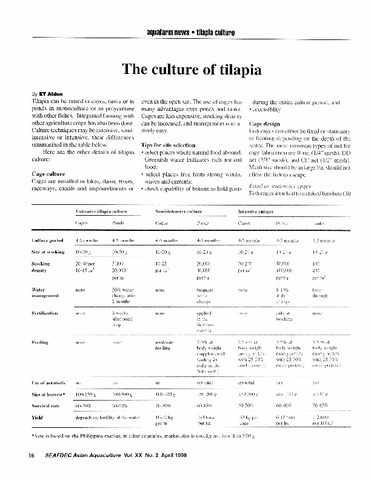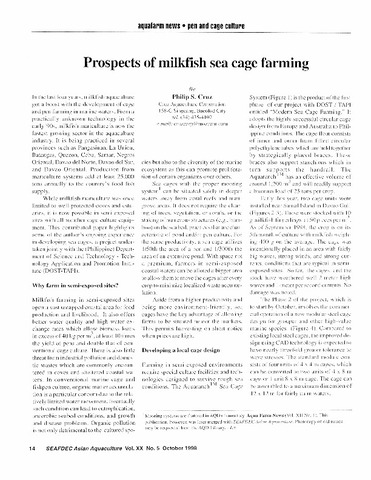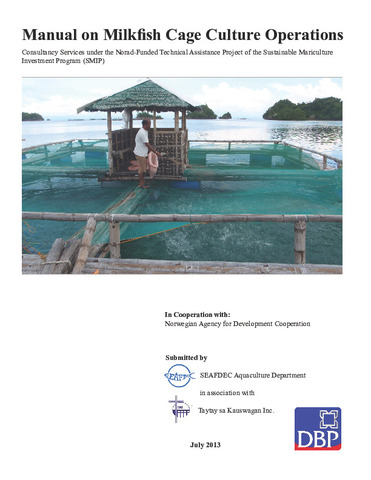Nursery rearing of the Asian catfish, Clarias macrocephalus (Günther), at different stocking densities in cages suspended in tanks and ponds
| dc.contributor.author | Bombeo, Ruby F. | |
| dc.contributor.author | Fermin, Armando C. | |
| dc.contributor.author | Tan-Fermin, Josefa D. | |
| dc.date.accessioned | 2014-01-17T05:35:23Z | |
| dc.date.available | 2014-01-17T05:35:23Z | |
| dc.date.issued | 2002 | |
| dc.identifier.citation | Bombeo, R. F., Fermin, A. C., & Tan-Fermin, J. D. (2002). Nursery rearing of the Asian catfish, Clarias macrocephalus (Günther), at different stocking densities in cages suspended in tanks and ponds. Aquaculture Research, 33(13), 1031-1036. | en |
| dc.identifier.issn | 1355-557X | |
| dc.identifier.uri | http://hdl.handle.net/10862/1919 | |
| dc.description.abstract | Growth and survival of hatchery-bred Asian catfish, Clarias macrocephalus (Günther), fry reared at different stocking densities in net cages suspended in tanks and ponds were measured. The stocking densities used were 285, 571 and 1143 fry m−3 in tanks and 114, 228 and 457 fry m−3 in ponds. Fish were fed a formulated diet throughout the 28-day rearing period. Generally, fish reared in cages in ponds grew faster, with a specific growth rate (SGR) range of 10.3–14.6% day−1, than those in cages suspended in tanks (SGR range 9–11.3% day−1). This could be attributed to the presence of natural zooplankton (copepods and cladocerans) in the pond throughout the culture period, which served as additional food sources for catfish juveniles. In both scenarios, the fish reared at lower densities had significantly higher SGR than fish reared at higher densities. In the pond, the SGR of fish held at 228 and 457 m−3 were similar to each other but were significantly lower than those of fish held at 114 m−3. The zooplankton in ponds consisted mostly of copepods and cladocerans, in contrast to tanks, in which rotifers were more predominant. Per cent survival ranged from 85% to 89% in tanks and from 78% to 87% in ponds and did not differ significantly among stocking densities and between rearing systems. In conclusion, catfish nursery in cages suspended in tanks and ponds is density dependent. Catfish fry reared at 285 m−3 in tanks and at 114 m−3 in ponds had significantly faster growth rates than fish reared at higher densities. However, the desired fingerling size of 3–4 cm total length for stocking in grow-out culture can still be attained at stocking densities of 457 m−3 in nursery pond and 571 m−3 in tanks. | en |
| dc.language.iso | en | en |
| dc.publisher | Blackwell Publishing | en |
| dc.subject | Cladocera | en |
| dc.subject | Clarias macrocephalus | en |
| dc.subject | Copepoda | en |
| dc.subject | Rotifera | en |
| dc.subject | freshwater catfish | en |
| dc.subject | Cage nursery | en |
| dc.title | Nursery rearing of the Asian catfish, Clarias macrocephalus (Günther), at different stocking densities in cages suspended in tanks and ponds | en |
| dc.type | Article | en |
| dc.identifier.doi | 10.1046/j.1365-2109.2002.00763.x | |
| dc.citation.volume | 33 | |
| dc.citation.issue | 13 | |
| dc.citation.spage | 1031 | |
| dc.citation.epage | 1036 | |
| dc.citation.journalTitle | Aquaculture Research | en |
| seafdecaqd.library.callnumber | VF SJ 0726 | |
| seafdecaqd.databank.controlnumber | 2002-36 | |
| dc.subject.asfa | aquaculture techniques | en |
| dc.subject.asfa | cage culture | en |
| dc.subject.asfa | culture tanks | en |
| dc.subject.asfa | fish ponds | en |
| dc.subject.asfa | fry | en |
| dc.subject.asfa | growth rate | en |
| dc.subject.asfa | rearing techniques | en |
| dc.subject.asfa | stocking density | en |
| dc.subject.asfa | survival | en |
| dc.subject.asfa | zooplankton | en |
Files in this item
| Files | ขนาด | รูป | View |
|---|---|---|---|
|
There are no files associated with this item. |
|||
รายการนี้ปรากฏใน (s)
-
Journal Articles [1258]
These papers were contributed by Department staff to various national and international journals.



